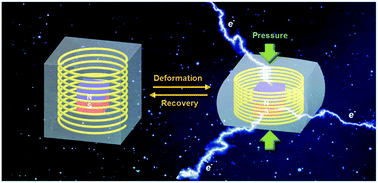Binary cooperative flexible magnetoelectric materials working as self-powered tactile sensors†
Abstract
The design of materials utilizing a binary cooperative concept can open up a new avenue for the development of self-powered sensors and has led to promising advances across diverse fields, including wearable electronic devices, human-computer communication, environment-adaptation, and soft robotics. Here we reported the fabrication of binary cooperative magnetoelectric elastomers and their application in self-powered tactile sensors. We found that electrical/magnetic building blocks with designed positions in the elastomers could convert mechanical forces into electrical signals, and exhibit an anisotropic piezoelectric effect. This unique functionality can be explained by Maxwell numerical simulation, allowing further improvement in their performance by tailoring different parameters. Owing to their self-powering, fast-response and sensitive properties, these elastomer-based sensors could work as smart shoes for monitoring sudden fainting in the elderly. Cross-selection of electrical (carbon or metallic nanomaterials) and magnetic (rare-earth metals doped with Fe/Co/Ni series) materials will provide a new binary material design concept to fabricate self-powered flexible sensors towards next-generation soft electronics.

- This article is part of the themed collection: 2019 Journal of Materials Chemistry C HOT Papers


 Please wait while we load your content...
Please wait while we load your content...